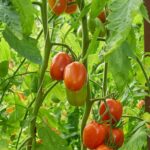Railroad ties are a popular choice for creating raised garden beds, but many gardeners have concerns about their safety, especially when it comes to growing vegetables. In this article, we will explore the potential risks and environmental impact of using railroad ties in vegetable gardens, as well as provide alternatives and tips for safely using them.
Using railroad ties in vegetable gardens can be a controversial topic, as there is ongoing debate about whether they are safe for growing food. Some believe that the chemicals used to treat railroad ties may leach into the soil and be absorbed by plants, while others argue that the risk is minimal.
In the following sections, we will delve into the potential risks of using railroad ties in vegetable gardens, discuss the environmental impact of these materials on garden soil, and provide alternative options for creating raised beds. Additionally, we will explore research on the safety of railroad ties in vegetable gardens and examine case studies to help you make an informed decision for your own garden.
Whether you are considering using railroad ties or seeking safer alternatives, it is important to weigh the pros and cons before making any decisions for your vegetable garden.
The Potential Risks of Using Railroad Ties in Vegetable Gardens
Chemical Contamination
One of the potential risks of using railroad ties in vegetable gardens is the risk of chemical contamination. Railroad ties are treated with creosote, a preservative that contains harmful chemicals such as polycyclic aromatic hydrocarbons (PAHs). These chemicals can leach into the soil and be absorbed by the plants, posing a risk to both the plants and anyone consuming them.
Soil Pollution
Another concern with using railroad ties in vegetable gardens is the potential for soil pollution. As the creosote-treated wood breaks down over time, it can release these harmful chemicals into the surrounding soil, contaminating not only the immediate area but also potentially spreading to neighboring garden beds.
Health Risks
In addition to harming the plants and soil, there are also health risks associated with using railroad ties in vegetable gardens. Exposure to PAHs has been linked to various health issues, including skin irritation, respiratory problems, and even an increased risk of certain types of cancer. This makes it crucial to carefully consider whether or not railroad ties are safe for use in vegetable gardens.
The Environmental Impact of Railroad Ties in Garden Soil
Railroad ties, also known as crossties or sleepers, have been utilized in gardening and landscaping for decades due to their durability and ability to create visually appealing raised beds. However, concerns about the safety of using railroad ties in vegetable gardens have been raised due to the potential environmental impact on garden soil.
One of the primary concerns regarding the use of railroad ties in garden soil is the risk of chemical contamination. Railroad ties are often treated with creosote, a chemical that protects the wood from decay and insect infestation. Creosote is composed of various chemicals, some of which are known to be toxic to humans and animals. When used in vegetable gardens, there is a possibility that these chemicals can leach into the surrounding soil and potentially contaminate crops.
Studies on the environmental impact of railroad ties in garden soil have shown that there is a risk of contamination from creosote. Research has indicated that creosote-treated wood can release harmful compounds into the soil, posing a threat to both human health and the environment. As a result, many experts caution against using railroad ties in vegetable gardens where edibles will be grown, especially without proper precautions in place.
| Environmental Impact | Railroad Ties |
|---|---|
| Potential Soil Contamination | Risk of leaching harmful chemicals |
| Chemical Composition | Contains creosote, which is toxic |
Alternatives to Railroad Ties for Raised Beds in Vegetable Gardens
Railroad ties have long been used to create raised beds in vegetable gardens due to their durability and affordability. However, concerns have been raised about the safety of using railroad ties in vegetable gardens, particularly regarding the potential risks and environmental impact they may pose. While some gardeners may still choose to use railroad ties, it’s important to consider alternative materials for raised beds that are safer for both the garden and those consuming the produce.
There are several alternatives to railroad ties that can be used for creating raised beds in vegetable gardens. These alternatives provide a safe and sustainable option for gardeners who are wary of using railroad ties. Some options to consider include:
- Cedar or redwood lumber: These types of wood are naturally resistant to rot and decay, making them a long-lasting and safe choice for creating raised beds.
- Concrete blocks: Concrete blocks can be stacked to create sturdy raised beds without the risk of chemicals leaching into the soil.
- Composite lumber: Made from wood fibers and recycled plastic, composite lumber is a durable and environmentally-friendly alternative to traditional wood.
- Galvanized steel or aluminum: Metal materials provide a modern and durable option for constructing raised beds that won’t degrade over time.
By exploring these alternatives, gardeners can still enjoy the benefits of raised beds in their vegetable gardens while ensuring the safety of their soil and produce.
In addition to considering alternative materials, it’s important for gardeners to also assess their own gardening practices when it comes to using railroad ties or any other material in their vegetable gardens. Ensuring proper drainage, soil quality, and regular soil testing can help mitigate any potential risks associated with using potentially unsafe materials in the garden.
It’s also wise to seek out research on the safety of various materials for use in vegetable gardens before making a decision on which materials are best suited for your specific gardening needs.
Tips for Safely Using Railroad Ties in Vegetable Gardens
When using railroad ties in vegetable gardens, it is important to take certain precautions to ensure the safety of the garden and those consuming the produce. While there are potential risks associated with using railroad ties due to the chemicals used to treat and preserve them, following these tips can help mitigate any potential harm.
Choose Untreated Railroad Ties
One of the most important tips for safely using railroad ties in vegetable gardens is to choose untreated or “new” railroad ties. Ties that have been treated with creosote or other harmful chemicals are not safe for use in vegetable gardens, as these chemicals can leach into the soil and contaminate the plants.
Use a Liner
To further prevent any chemicals from leaching into the soil, consider using a liner between the railroad ties and the garden bed. A thick plastic liner can act as a barrier, preventing direct contact between the ties and the soil.
Monitor Plant Health
Regularly monitor the health of your plants when using railroad ties in your vegetable garden. Look for any signs of stress or discoloration that could be indicative of chemical exposure. If you notice any issues, consider testing the soil for contaminants and take necessary steps to address any potential problems.
By following these tips, you can incorporate railroad ties into your vegetable garden while minimizing any potential risks associated with their use. However, it is important to note that alternatives to railroad ties may be a safer option for creating raised beds in vegetable gardens, especially if there are concerns about chemical leaching and environmental impact.
Research on the Safety of Railroad Ties in Vegetable Gardens
Railroad ties have been a popular choice for building raised beds in vegetable gardens due to their durability and affordability. However, there has been growing concern about the safety of using railroad ties in vegetable gardens, as they are treated with creosote, a chemical that can leach into the soil and potentially contaminate the plants.
Studies have shown that creosote, which is used to preserve the wood in railroad ties, contains harmful chemicals such as polycyclic aromatic hydrocarbons (PAHs) that can be toxic to plants and humans. When creosote-treated railroad ties are used in vegetable gardens, there is a risk of these chemicals leaching into the soil and being absorbed by the plants. This raises concerns about the safety of consuming vegetables grown in soil contaminated with creosote.
In addition to the potential health risks, there are also environmental concerns associated with using railroad ties in garden soil. The chemicals from creosote-treated wood can leach into the surrounding environment, contaminating groundwater and impacting local ecosystems. These risks highlight the importance of carefully considering the use of railroad ties in vegetable gardens and exploring safer alternatives for building raised beds.
| Concerns | Impacts |
|---|---|
| Potential health risks | Toxicity to plants and humans |
| Environmental impact | Contamination of groundwater and ecosystems |
Case Studies of Vegetable Gardens With Railroad Ties
When considering whether railroad ties are safe for vegetable gardens, it can be helpful to look at case studies of vegetable gardens that have used railroad ties. One common concern with using railroad ties in vegetable gardens is the potential for chemical contamination.
In some case studies, gardeners have reported positive experiences with using railroad ties, citing their durability and affordability as key benefits. However, it is important to note that these case studies may not fully capture the long-term effects of using railroad ties in vegetable gardens.
In one case study conducted by a group of researchers, they found that vegetables grown in raised beds constructed with railroad ties had significantly higher levels of certain chemicals, such as creosote, compared to vegetables grown in other types of raised beds. This suggests that there may be potential health risks associated with consuming vegetables from gardens built with railroad ties.
While this is just one study, it highlights the need for further research on the safety of using railroad ties in vegetable gardens.
Additionally, another case study documented the environmental impact of using railroad ties in garden soil. The researchers found that the chemicals from the railroad ties had leached into the surrounding soil, leading to contamination and potential harm to plant and animal life.
This case study raises important questions about the long-term sustainability of using railroad ties in vegetable gardens and emphasizes the need for careful consideration before incorporating them into garden projects. Overall, these case studies underscore the importance of thoroughly researching and considering the potential risks before using railroad ties in vegetable gardens.
Conclusion
In conclusion, when it comes to using railroad ties in vegetable gardens, it is important to carefully consider the potential risks and environmental impact. While railroad ties can be an affordable and convenient option for constructing raised beds, there are concerns about the safety of using treated wood in close proximity to edible plants. The chemicals used to treat railroad ties may leach into the soil over time, posing a potential risk to human health.
It is crucial for gardeners to weigh the potential risks against the benefits of using railroad ties in their vegetable garden. There are alternative materials available for constructing raised beds, such as untreated hardwood, cedar, or composite lumber, that may offer a safer option for growing vegetables. Additionally, with proper precautions such as lining the bed with a barrier and monitoring soil quality regularly, it may be possible to mitigate some of the risks associated with using railroad ties.
Ultimately, making an informed decision about whether or not to use railroad ties in a vegetable garden requires careful consideration of the potential risks and environmental impact. It is important for gardeners to take into account their own values and priorities when it comes to gardening practices. Conducting thorough research and consulting with experts can help gardeners make a well-informed decision that aligns with their goals for growing healthy and safe produce.
Frequently Asked Questions
Can You Use Railroad Ties for Raised Garden Beds?
Railroad ties can be used for raised garden beds, but it’s important to consider the potential risks. The chemicals in the wood can leach into the soil, which may not be ideal for growing edible plants.
Do Railroad Ties Leach Chemicals Into the Soil?
Yes, railroad ties are treated with chemicals like creosote, which can leach into the soil over time. These chemicals can be harmful to plants and people if ingested or absorbed through the skin.
What’s the Problem With Railroad Ties in a Garden?
The main problem with using railroad ties in a garden is the potential for chemical contamination. The toxic substances used to treat the wood can harm plants and pose health risks to those tending to the garden. It’s important to weigh the pros and cons before using railroad ties in a garden setting.

If you’re looking to get into vegetable gardening, or are just looking for some tips on how to make your current garden better, then you’ve come to the right place! My name is Ethel and I have been gardening for years. In this blog, I’m going to share with you some of my best tips on how to create a successful vegetable garden.





